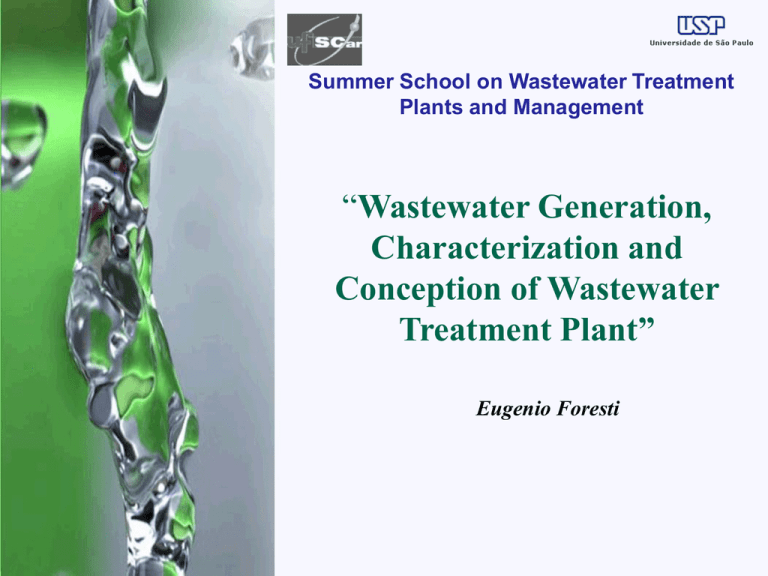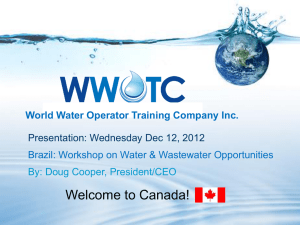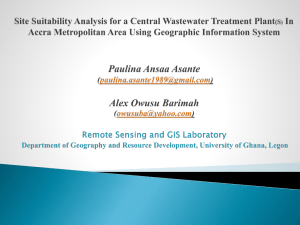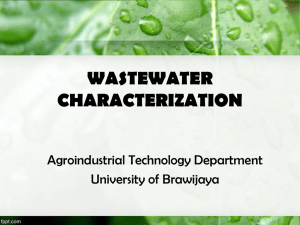Wastewater Generation, Characterization and The
advertisement

Summer School on Wastewater Treatment Plants and Management “Wastewater Generation, Characterization and Conception of Wastewater Treatment Plant” Eugenio Foresti Water Pollution Water Pollution Alterations of water quality due to discharge of wastes from point or diffuse sources. Wastewater Treatment Water Pollution controll the source. New Trend Biorefineries Treatment of wastes at Water Pollution Main pollutants: Organic carbon Nitrogen compounds Sulfur Compounds Heavy metals Microorganisms (contamination) Water Pollution: Role of Carbon, Nitrogen, Phosphorus and Sulphur Compounds Carbon: Organic carbon compounds source of carbon and energy for heterotrophic microorganisms. They catalize oxidationreduction reactions involving organic carbon compounds as source of carbon and energy for growth and maintenance. Organic matter decomposition in water bodies causes pollution. Inorganic carbon (CO2) carbon source for growth of autotrophic microorganisms that use sunlight or mediate oxidationreduction reactions envolving inorganic compounds as energy source (e.g. NH4+, S0, HS-, Fe3+...) Water Pollution: Role of Carbon, Nitrogen, Phosphorus and Sulphur Compounds Nitrogen (N) essential nutrient for cellular synthesis of amino acids by microrganisms. In nature, N2 is sinthetized by green plants, released as ammonia nitrogen by degradation of nitrogen containing organic matter, and oxidized by autotrophic processes. Phosphorus (P) essential nutrient for microorganisms synthesis and maintenance (energy transfer - ATP/ADP system). In water bodies, P is found as phosphate and it is the main responsible for eutrophication. Sulphur (S) present in many compounds used in industries and as organic sulphur. In the aquatic environment S is found as oxidized compounds (e.g. sulfate) or reduced compounds (e.g. sulfide). Water Pollution: Role of Carbon, Nitrogen, Phosphorus and Sulphur Compounds Changes of the oxidation state of Carbon, Nitrogen and Sulphur occurring in water bodies: - depletion of dissolved oxygen - formation of indesirable products - formation of inert products Water Pollution: Role of Carbon, Nitrogen, Phosphorus and Sulphur Compounds Organic Matter (OM) Decomposition Aerobic Environment Heterotrophic microorganisms consume dissolved oxygen while transform OM into CO2, H2O and new cells. Aquatic environment become not viable for superior forms of life (e.g. fish). Anaerobic Environment OM is not completely oxidized. Reduced organic compounds can be released. Methane and other organic compounds are formed. Water Pollution: Role of Carbon, Nitrogen, Phosphorus and Sulphur Compounds Nitrogen (N) Organic nitrogen (ON) is a constituent of organic matter. ON is first converted to ammonia nitrogen (AN NH3, NH4+). After, under aerobic condition, ammonia nitrogen is sequencially converted to nitrite and nitrate. Nitrogen removal occurs when nitrogen oxidized compounds (Nox) are biologically converted to N2. Phosphorus (P) organic P is liberated as phosphate. Phosphate can be removed from the liquid phase by chemical precipitation or as phosphate-rich biological sludge. N and P micro-nutrients responsible for eutrophication of lakes and reservoirs. 8 Water Pollution: Role of Carbon, Nitrogen, Phosphorus and Sulphur Compounds Organic and Inorganic Sulphur compounds (S) some proteins have S in their composition and most wastewater contain oxidized sulphur compounds. All sulfur compounds are converted to sulfate under aerobic conditions. Sulfide is produced under anaerobic conditions from organic matter decomposition and sulfate biochemical reduction. Main Characteristics of Wastewater of Interest for Designing WTP Roughly wastewaters can be classified as: Predominantly organic – Biological treatment is easily applicable for removing OM. Predominantly inorganic – Physical-chemical treatment may be applicable. Predominantly organic but containing toxic or recalcitrant compounds – Biological treatment may be possible after removing indesirable compounds. Knowledge of the main characteristics of the wastewater: very important for designing a proper WTP. Main Characteristics of Wastewater of Interest for Designing WTP Organic Matter How to access Chemical Oxygen Demand – COD Biochemical Oxygen Demand – BOD Total Organic Carbon – TOC 11 Main Characteristics of Wastewater of Interest for Designing WTP COD Fractionation TOTAL COD COD B COD RB COMPLEX VFA COD NB COD SB COLOIDAL COD PNB COD SNB PARTICULATE B – biodegradable; NB – nonbiodegradable; RB – readly biodegradable; SB – slowly biodegradable; PNB – nonbiodegradable (particulate); SNB – nonbiodegradable (soluble) VFA – Volatile Fatty Acids Main Characteristics of Wastewater of Interest for Designing WTP Solids – How to access Total Solids (TS) – residue remaining after evaporation and drying of wastewater sample in stove (103 to 105oC) Volatile Solids (VS) – solids that can be volatilized and burned off when the TS are incinerated (500±50 oC) Suspended Solids (SS) – portion of TS retained on a glass fiber filter (pore size ~ 1.5 µm) Dissolved Solids (DS) – solids that passes through the filter 13 Main Characteristics of Wastewater of Interest for Designing WTP Solids in Wastewater - Fractionation Total Volatile Solids (TVS) 1. Suspended Volatile Solids (SSV) 2. Dissolved Volatile Solids (DVS) TVS = SSV + DSV Total Fixed Solids (TFS) 1. Suspended Fixed Solids – (SFS) 2. Dissolved Fixed Solids – (DFS) TFS = SFS + DFS Nitrogen in Wastewater – How to access Nitrogen Fractionation Organic Nitrogen Ammonia Nitrogen Nitrite Nitrate NTK Nitrogen fractionatin TKN Ammonia N Organic N Biodegradable Soluble Particulate Nonbiodegradable Soluble TKN – 60 – 70% as NH4+ Nonbiodegradable N ~ 6% of SSV expressed as COD Particulate Sulphur Sulfates and other sulphur oxidized compounds – important because are reduced to sulfide under anaerobic conditions Sulfides – may cause toxicity to biomas in biological process; if in the gas phase - odor and corrosion Elemental Sulphur – may be formed in micro-aerobic aquatic environment pH – biological wastewater treatment are better conducted at pH close to neutrality (6.6 to 7.8). pH is one of the environmental factor thet selects the microorganisms population. As far from the optimum range, as selective the environment becomes. Temperature – optimum ranges psicrophylic (12 - 18 oC) mesophylic (25 - 40 oC) thermophylic (55 – 65 oC) Temperature also selects the biomass; as far from the optimum range, as selective the environment becomes. Alkalinity – important as pH buffer Due to the presence of hydroxides, carbonates and bicarbonates. In the pH range of interest – bicarbonate alkalinity predominates Bicarbonate Alkalinity (BA) – (HCO3-) – very important for pH controll of anaerobic processes and also as carbon source in autotrophic biological processes Oils and Grease (O&G) - high O&G (fatty compounds) may l ead biological process to colapse. Normally O&G is separated before the biological treatment units Seattleable Solids (SeS) – inform on the volume occupied by suspended solids that seattle after 60 min in Imhoff flask Heavy metals – possible toxicity 20 Pathogens Bacteria – evaluated by the MPN (Most Probable Number) of E. Coli (fecal coliform); E. Coli is not a pathogenic microorganism. It is just an indicator of fecal contamination Protozoa – evaluated for specific organisms (Cryptosporidium parvum - oocysts, Entamoeba histolytica – cysts, Giardia lambria – cysts) Helminths – evaluated by counting eggs. 21 Interrelationships of Constituents BOD/COD > 0.5 biological processes. 0.3 < BOD/COD < 0.5 probable presence of acclimatization wastewater easily treated by biological treatment possible; inhibitors; need for biomass BOD/COD < 0.3 – biological treatment difficult without pretreatment Interrelationships of Interest Between Some Wastewater Constituents FS/VS – high values indicate predominance of inert matter DFS/DVS – high values indicate high salinity VSS/FSS – low values indicate high stabilized SS Other information of interest: Raw samples – FSS concentration can be associated to the amount of grit in the influent COD = 1.42 VSS Wastewater Treatment Flow Equalization Flow equalization – becomes necessary when variations in flow over time can impair the functioning of the treatment units Units: storage tank and pumping facilities. Procedure to obtain the storage tank volume and the equalized flow Wastewater Treatment Flow Equalization m3 V = 70 m3 Q = 13.55 m3.h-1 h Wastewater Treatment Homogenization Homogenization: Required when changes in composition of the wastewater are very significant, that it could cause instability in the processes (chemical or biological) treatment. There is no suitable method homogenization tank volume. to obtain the Wastewater Treatment Homogenization Industrial wastewater: Verify the possibility to hold effluents from operations that occur sporadically throughout the day in separated tanks. The effluents from these tanks are released throughout the day. Verify the effluents treatment. according effluent. convenience of treating the segregated separately or mixing them before The best option should be chosen to the characteristics of the final . The Treatment System as a Sequence of Phase Separation and Conversion Process Units Steps and Correspondig Objetives 1. Preliminary Treatment – Removal of grit and coarse material in suspension – Protection of equipment and facilities. The separated wastes go to landifill. 2. Primary Treatment – Removal and stabilization of settleable solids and fats (oils and greases). Generates stabilized sludge. Further treatment is necessary to eliminate microorganisms and transform stabilized sludge in biosolids. The Treatment System as a Sequence of Phase Separation and Conversion Process Units Steps and Objectives – cont. 3. Secondary Treatment – Removal of biodegradable organic matter. Generates biological sludge to be stabilized and properly disposed off. 4. Tertiary Treatment – Removal of nutrients (N, P). Generates small amount of biological sludge. May generate phosphate-rich sludge. 5. Advanced Treatment – Polishing of effluent for reuse. Generates by products with high salt concentration. The Treatment System as a Sequence of Phase Separation and Conversion Process Units Steps and Objectives – cont. 5. Advanced Treatment – Polishing of effluent for reuse. Generates byproducts with high concentration of salts. Steps 1 to 5 – removal of organic matter and some specific compounds (N, P and salts). Desinfection is an important step before discharging contaminated wastewater in water bodies. The Treatment System as a Sequence of Phase Separation and Conversion Process Units Phase Separation Units: Screen – coarse material Grit Chamber – grit Primary Settler – setteable solids; oil and grease Secondary Settler – biological sludge Thickening Sludge Unit – pre-settled biological sludge The Treatment System as a Sequence of Phase Separation and Conversion Process Units Phase Separation Units: cont. Flotation Unit – suspended solids Dewatering Units (centrifuge, filter press, vacuum filter, etc.) – biological or chemical sludge Membrane Units (ultrafiltration, microfiltration, reverse osmosis) – very small particles, molecules The Treatment System as a Sequence of Phase Separation and Conversion Process Units Conversion Process Units: Biological Reactors Aerobic Reactors – organic matter, nitrogen and sulphur reduced compounds Anaerobic Reactors – organic matter, nitrogen and sulphur oxidized compounds Anoxic Reators – nitrogen oxidized compounds Anaerobic Ponds Photosynthetic Ponds The Treatment System as a Sequence of Phase Separation and Conversion Process Units Conversion Process Units: cont. Phisycal-Chemical Reactors Flocculation Unit – suspended solids Chemical precipitation Unit – metals Desinfection Unit - microorganisms The Treatment System as a Sequence of Phase Separation and Conversion Process Units Typical Activated Sludge WTP – Franca – SP – Brazil – Operated by SABESP Sector 1 – screen, grit chamber , pumping Sector 2 – primary sedimentation Sector 3 – aeration tanks Sector 4 – secondary sedimentation Sector 5 – sludge thickening Sector 6 – sludge anaerobic digestion Sector 7 – sludge dewatering The Treatment System as a Sequence of Phase Separation and Conversion Process Units Compact WTP based on anerobi reactor (UASB) as the main organic matter removal unit - WTP Piracimirim – Piracicaba – SP - Brazil (Operated by SEMAE) Summer School on Wastewater Treatment Plants and Management Thank you for your attention









